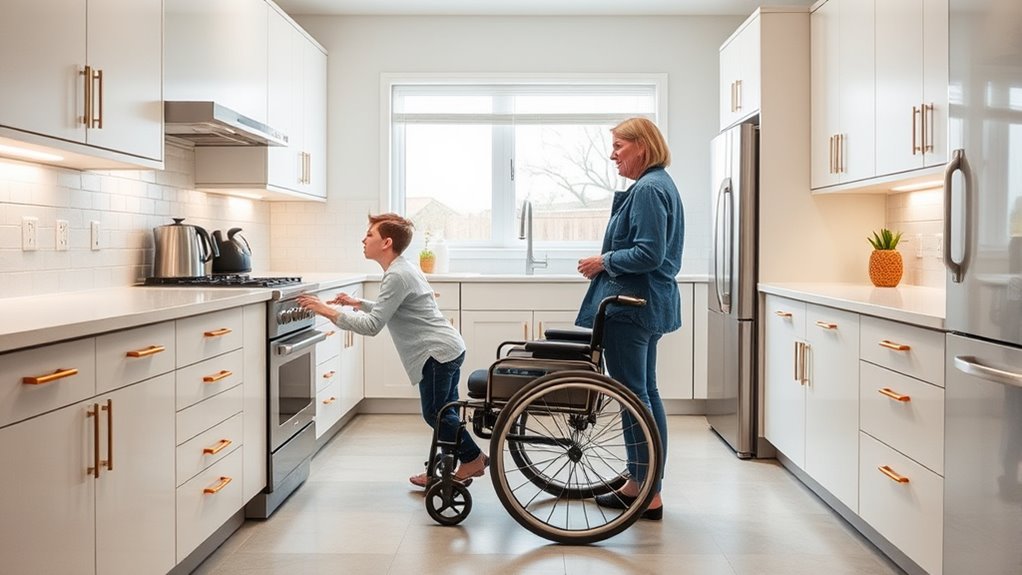Designing an inclusive kitchen means creating a space that’s safe, accessible, and functional for everyone, regardless of ability. You can achieve this by incorporating adjustable countertops, placing appliances at reachable heights, and avoiding high thresholds and narrow corners. Use features like lever handles and anti-slip surfaces to enhance safety and ease of use. Thoughtful layout and lighting support all users’ needs, fostering independence and comfort. Keep exploring to discover more ways to make your kitchen truly inclusive.
Key Takeaways
- Incorporate adjustable countertops and lowered sections to accommodate different heights and wheelchair users.
- Position appliances at accessible heights and use side-opening or drawer-style options for easier reach.
- Design clear, unobstructed pathways with smooth transitions to support diverse mobility needs.
- Use lever-style handles, rounded edges, and non-slip surfaces for enhanced safety and ease of use.
- Ensure ample, glare-free lighting and an inclusive layout that promotes independence for all users.

Creating a kitchen that works for everyone isn’t just a trend—it’s a necessity. When designing a space that’s accessible and functional for people of all abilities, you need to think about adaptive countertops and universal appliance placement. These features ensure that anyone, regardless of mobility or strength, can navigate and use the kitchen comfortably. Adaptive countertops are designed to accommodate different heights and needs. You might consider installing adjustable-height surfaces or countertops with a lowered section that makes it easier for someone in a wheelchair to access food prep areas without strain. These countertops can also include features like rounded edges or non-slip surfaces to prevent accidents. When you plan for adaptive countertops, you’re creating a versatile workspace that adapts to the user, rather than forcing the user to adapt to the space.
Universal appliance placement plays an equally vital role in inclusive kitchen design. Instead of positioning appliances in a way that’s hard to reach or requiring awkward maneuvers, you should place them at heights and locations that are accessible for everyone. For example, mounting microwave ovens at waist level or installing side-opening refrigerator doors makes them easier to use for those with limited reach or strength. You might also consider drawer-style dishwashers or ovens that open from the front, eliminating the need to bend or stretch. When you incorporate universal appliance placement, you’re not only making the kitchen more inclusive but also more efficient for all users. It encourages a seamless flow, reduces clutter, and minimizes the risk of strain or injury.
Designing with adaptive countertops and universal appliance placement in mind requires careful planning, but the payoff is a space that truly serves everyone. Think about the movement patterns and physical needs of potential users during the layout process. Keep clear pathways and avoid high thresholds or tight corners that could hinder mobility. Use lever-style handles instead of knobs for easier operation, and ensure lighting is ample and glare-free to assist users with visual impairments. By integrating these features thoughtfully, you create a kitchen that’s welcoming and practical, encouraging independence and safety. Ultimately, inclusive kitchen design isn’t just about meeting current standards; it’s about creating a space that respects and adapts to the diverse needs of all who use it.
Frequently Asked Questions
How Can I Incorporate Sensory-Friendly Features Into My Kitchen?
You can make your kitchen more sensory-friendly by adding sensory-friendly lighting, like soft, adjustable options that reduce glare and create a calming atmosphere. Incorporate textured cabinet surfaces to provide tactile stimulation and sensory input. Use non-slip mats for safety and choose calming colors to enhance comfort. These features help create a space that’s accessible and enjoyable for everyone, regardless of sensory sensitivities.
What Budget Options Exist for Accessible Kitchen Renovations?
Did you know that 60% of homeowners save money by choosing DIY accessibility upgrades? For budget-friendly options, consider simple fixes like lever handles, pull-out shelves, or adjustable countertops. You can also explore DIY accessibility projects, like installing grab bars or lowering cabinets yourself. These affordable solutions make your kitchen more inclusive without breaking the bank, helping you create a space that’s easier and safer for everyone.
Are There Specific Brands Known for Inclusive Kitchen Products?
You can find brands known for inclusive kitchen products through their collaborations and product certifications. Look for brands partnering with accessibility organizations or earning certifications like ADA compliance, which guarantees their products meet universal design standards. Popular brands often showcase their inclusivity efforts via collaborations with accessibility experts. These collaborations signal a commitment to inclusive design, making it easier for you to select products that accommodate a variety of needs and abilities in your kitchen.
How Can I Ensure Safety for Children and Elderly in Inclusive Kitchens?
Imagine a space where everyone feels safe and comfortable. To achieve this, you should implement child proofing measures like outlet covers and stove knob covers, and choose elderly friendly fixtures such as lever handles and non-slip flooring. Keep sharp objects out of reach, maintain good lighting, and guarantee easy-to-use appliances. Regularly check these safety features to create a secure environment where children and seniors can enjoy cooking without worry.
What Is the Maintenance Requirement for Adaptive Kitchen Features?
You should establish regular cleaning routines for adaptive kitchen features to keep them safe and functional. Check for wear and tear, and replace parts as needed to prevent accidents or malfunctions. Keep surfaces clean to avoid buildup that could cause issues. By staying proactive with maintenance, you guarantee your adaptive features remain reliable and safe for everyone, especially children and elderly users. Consistent upkeep prolongs their lifespan and maintains a secure, accessible cooking environment.
Conclusion
By designing your kitchen with everyone in mind, you’re creating a space that welcomes all like a open door beckons friends inside. Think of your kitchen as a symphony where each note, regardless of ability, contributes to a beautiful harmony. When you prioritize inclusivity, you build more than just a functional space—you craft a heart of your home that embraces diversity and fosters connection. Together, you turn cooking into a shared experience, rich with opportunity for all.









